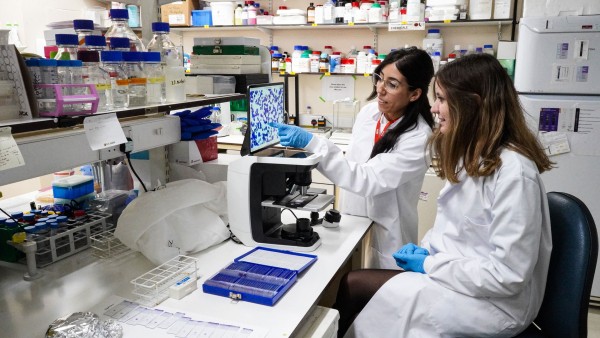23 May 2024
Michelle Cartin is one of the leads within the clinical ultrasound postgraduate taught programme, run by the Department of Women and Children’s Health at King’s College London. Michelle oversees the obstetrics and gynaecology ultrasound teaching. In this blog she explains why diagnosis for endometriosis needs to improve and explains how ultrasound could be the solution. She also shares how she worked with Dr Susanne Johnson, an Associate Specialist in Gynaecology to create a new course with the aim of improving diagnosis.
What is Endometriosis and what are the symptoms?
Endometriosis is a chronic condition where tissue that normally lines the uterus, known as the endometrium, starts to grow outside the uterus - such as in the ovaries and fallopian tubes. This can lead to a range of symptoms, including:
- Pelvic pain, especially during menstruation,
- Pain during intercourse,
- Painful bowel movements,
- Difficulty urinating during menstrual periods,
- Some individuals may experience infertility, fatigue, and gastrointestinal symptoms like diarrhoea, constipation, bloating, or nausea, particularly during menstrual periods.
Endometriosis affects the physical and mental health of 1 in 10 women, and it can affect women of childbearing age from puberty to menopause. The exact cause of endometriosis is not fully understood, but it may involve hormonal imbalances, genetic predisposition, and immune system issues. While there is no cure,, treatments are available to manage symptoms, including pain relief medications, hormone therapy and surgery.
Diagnosis typically involves a pelvic examination, imaging tests, such as ultrasound and MRI, and sometimes keyhole surgery, known as laparoscopy. A laparoscopy involves inserting a camera into the pelvis to visually confirm the presence of endometrial tissue outside the uterus. However, a laparoscopy is usually the last resort after other non-invasive methods like ultrasound fail to provide conclusive evidence.
How long does it take to diagnose Endometriosis?
The diagnosis of endometriosis can be a prolonged process, often taking several years. Research indicates an average of eight years between the onset of symptoms and a definitive diagnosis in the UK. This delay is attributed to a variety of factors, including the non-specific nature of symptoms that overlap with other common conditions, leading to misdiagnosis or dismissal of symptoms. Additionally, societal, and personal barriers, as well as a lack of awareness among both patients and healthcare professionals, contribute to the delay. The complexity of the disease, variability of symptoms, and the normalisation of menstrual pain further complicate timely diagnosis and treatment.
How is King's Health Partners (KHP) supporting improvements in the diagnosis of Endometriosis?
King’s Health Partners is at the forefront of enhancing endometriosis care, a condition impacting many women globally. We engage in various activities to improve treatment for patients:
- Accredited Endometriosis Clinics: KHP advise individuals suspecting endometriosis to seek referrals to specialised NHS gynaecology clinics, endorsed by the British Society for Gynaecological Endoscopy (BSGE).
- Education for ultrasound practitioners: The ability to detect endometriosis varies with the stage of the condition hence the need to educate practitioners. In the right hands ultrasound can detect many gynaecology conditions.
- Treatment Options: KHP offers a range of treatments post-diagnosis, including hormone therapy to manage symptoms, pain management strategies, and surgical intervention.
These efforts by King’s Health Partners demonstrate a commitment to advancing the understanding and management of endometriosis, providing hope and support to those living with this chronic condition.
What can professionals do to support improvements in diagnosis?
We can adopt a more symptom-focused approach and grow our appreciation for the role of ultrasound in diagnosing endometriosis. Gynaecology ultrasound services should offer precise diagnosis so that treatments can be better tailored to the individual. By making these changes we can support earlier detection and more timely management to reduce treatment delays. The aim of these changes is to enhance patient care, improve treatment outcomes, minimise anxiety, and improve mental health for patients.
Through my role at King’s, I’ve had the pleasure of collaborating with Dr Susanne Johnson, an Associate Specialist in Gynaecology who is one of our guest lecturers and a leading advocate for enhanced gynaecology ultrasound education. As our partnership evolved, we joined forces to create a new course on Advanced Gynaecology Ultrasound. Changes in diagnostic procedures can have a significant impact on treatment, so we want to educate healthcare professionals in ultrasound examination techniques to help speed up and improve diagnosis. Education can be crucial for conditions where early treatment can halt or slow progression.
Why should staff sign up to the Advanced Gynaecology Ultrasound course?
Our course equips ultrasound practitioners with detailed knowledge of advanced gynaecology ultrasound and enhances their diagnostic capabilities. The course offers an intimate learning experience, allowing staff to engage closely with expert faculty in small group settings. Together we consider how to distinguish between normal and abnormal pelvic ultrasounds more accurately. We critically evaluate the evidence base for current methods and techniques used in gynaecology imaging and reflect on the impact of these in healthcare practice to improve service delivery.
Our course also supports professional development by allowing staff to appraise their role, ensuring their practice meets accepted standards of care. Overall, this new course is an excellent opportunity for professional growth towards improving patient care in gynaecology.
What are your hopes for the patients and services in the future?
The future of gynaecology ultrasound services is indeed bright. Enhanced ultrasound technology, including advanced 3D and 4D imaging, promises to offer deeper insights into health. Moreover, the shift towards personalised care underscores a commitment to service with patients at their centre, ensuring that scans are as comfortable and convenient as possible. Ultimately, the work we are doing aims to foster a more equitable healthcare system where every patient has access to high-quality, timely, and effective diagnostic services.





